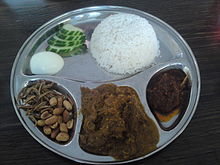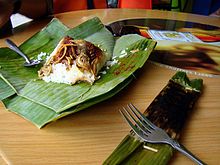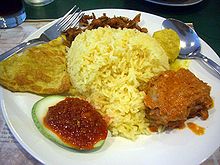- Nasi lemak
-
Nasi lemak is a dish sold in Malaysia, Brunei, Singapore,[1] Riau Islands and Southern Thailand. The dish is considered the national dish and a national heritage of Malaysia.[2] It is not to be confused with Nasi Dagang sold on the east coast of Malaysia or Terengganu and Kelantan although both dishes can usually be found sold side by side for breakfast. However, because of the nasi lemak's versatility in being able to be served in a variety of manners, it is now served and eaten any time of the day.
With roots in Malay culture, its name is a Malay word that literally means "fatty rice". The name is derived from the cooking process whereby rice is soaked in coconut cream and then the mixture steamed. Sometimes knotted screwpine (pandan) leaves are thrown into the rice while steaming to give it more fragrance. Spices such as ginger and occasionally herbs like lemon grass may be added for additional fragrance.
Traditionally, this comes as a platter of food wrapped in banana leaves, with cucumber slices, small fried anchovies (ikan bilis), roasted peanuts, hard boiled egg, and hot spicy sauce (sambal) at its core. As a more substantial meal, nasi lemak can also come with a variety of other accompaniments such as chicken, cuttlefish, cockles, stir fried water convolvulus (kangkong), pickled vegetables (acar), beef rendang (beef stewed in coconut milk and spices) or paru (beef lungs). Traditionally most of these accompaniments are spicy in nature.
Nasi lemak is widely eaten in Malaysia and Singapore, even as a dish served in Malaysian schools. Commonly a breakfast dish in both countries, it is normally sold at hawker food centres in Singapore and roadside stalls in Malaysia. It often comes wrapped in banana leaves, newspaper or brown paper,and it could be served on a plate. However, there are restaurants which serve it as a noon or evening meals, making it possible for the dish to be eaten all day. Nasi lemak kukus which means "steamed nasi lemak" is another name given to nasi lemak served with steamed rice.
Contents
Different versions
In Malaysia and Singapore, nasi lemak comes in various versions as they are prepared by different chefs in different cultures. Hotels have nasi lemak on their menu with elaborate dishes, such as beef rendang and the addition of other seafood. Hawker centres in Singapore usually wrap them in banana leaves to enhance the flavour. Roadside stalls sell them ready packed, known as "nasi lemak bungkus", with minimal additions that cost between RM 1–7 per pack. There are Malaysian Chinese and Malaysian Indian versions, and Singaporean Malay and Singaporean Chinese versions.
Malaysian Indian version
The Malaysian Indian version is similar to the original version. However, many Malaysian Indians are Hindus, and do not eat beef. Therefore, beef is not included while preparing the Malaysian Indian version of nasi lemak.
Malaysian Chinese version
Although it is not common to see Malaysian Chinese stalls and restaurants selling nasi lemak, there is a non-halal version that contains pork sold in towns and cities such as Malacca and certain parts of Kuala Lumpur. Some Malaysian Chinese hawkers are known to make minced pork sambal.
Riau Islands version
Similar to Malaysian version with a kind of small fish called ikan tamban, usually fried with sambal and very crispy, whole fish is edible.
Singaporean Malay version
This traditional favourite offers ikan bilis (the Malay version of anchovies) and nuts, fried fish, cucumber and sometimes an egg.
Singaporean Chinese version
Retaining the familiar aroma of pandan leaves, the Chinese variation comes with a variety of sides that includes deep fried drumstick, chicken franks, fish cake, curried vegetables and luncheon meat.
Vegetarian version
In certain parts of Kuala Lumpur, some Malaysian Chinese and Malay hawkers also offer vegetarian nasi lemak in which the dried anchovies is substituted with vegetarian mock anchovies.
See also
Gallery
-
Other ingredients such as fried chicken wing and sliced cucumber are often added to nasi lemak
External links
Notes and references
- ^ YourSingapore.com - Nasi lemak
- ^ "Nasi Lemak". Malaysia.com. http://www.malaysia.com/nasi-lemak-food.html. Retrieved 2010-07-06.
Malaysian cuisine by ethnicity Malay Chinese - Bakkwa
- Bak kut teh
- Pao
- Char kway teow
- Chee Cheong fun
- Hainanese Chicken Rice
- Hokkien mee
- Pan Mee
- Popiah
- Tong sui
- Wonton mee
- Yong Tau Foo
Indian Nyonya Other - ABC
- Cendol
- Mee goreng
- Nasi Goreng
- Nasi goreng paprik
- Rojak
- Satay
See also: List of Malaysian dishes Categories:- Malay cuisine
- Malaysian cuisine
- Singaporean cuisine
- Rice dishes
- Breakfast foods
- National dishes
- Malay words and phrases
Wikimedia Foundation. 2010.





